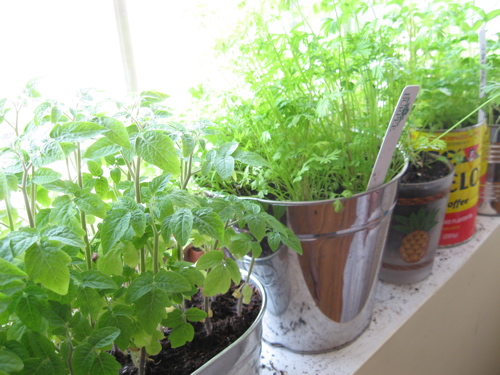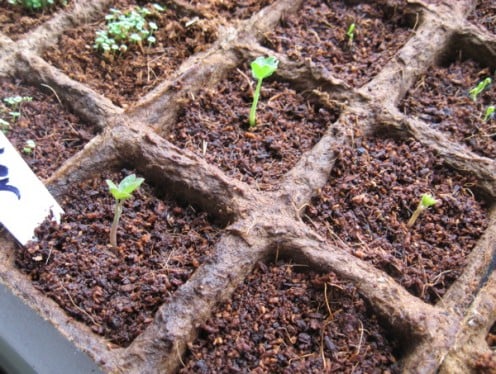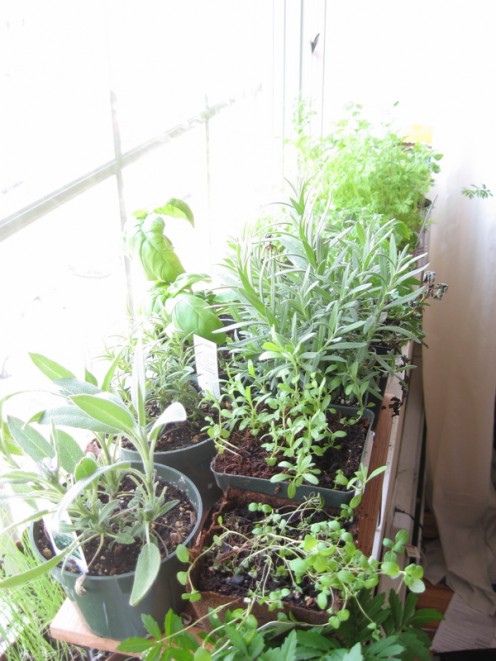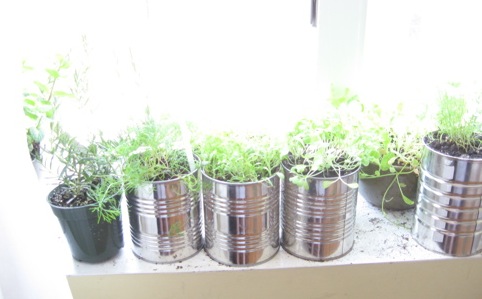The One Window Herb Garden

STARTING A ONE WINDOW GARDEN
Even if only one window in your house or apartment gets good light, it's possible to start an herb garden.
You may not have enough room or enough direct sunlight to allow a towering basil plant to flourish. But if you give up on the dream of fresh pesto nightly, you'll still be able to find satisfaction in harvesting pinches and sprigs of your own homegrown herbs.
If you get adventurous, mix up a row of culinary herbs with miniature vegetable plants and edible flowers.
From this in early March ...

... to this in early May


What you will need: You'll need seeds, potting soil, small pots, water and your own hands. That's really it. To find tiny containers good for sprouting seeds, try old yogurt containers, tuna fish cans, or spring for a $2.65 10-pack of seed starting fiber pots.
What you can skip: For a tiny windowsill garden, there's no need for a shovel or large watering can. You can improvise. A plastic fork is all you'll need to ease a seedling out of its first container and into a larger pot. Try a spray bottle (or even a plastic cup and a turkey baster) for controlled watering. You won't need fertilizer or compost. You won't need grow lights unless your window is extremely dark.
TIPS FOR PLANTING DAY
Get used to dirt: However neat you are, stuffing soil into tiny pots will make a mess. Put down newspaper or pour over an old mixing bowl. If you have some outdoor space and it isn't too brisk outside, use it. Just don't start this project without a good way to clean up, and don't expect to be happy with the condition of your usual dust brush after you've dragged it through potting soil.
Love your labels: Use garden markers like there's no tomorrow. Don't get so caught up in planting that you skip this step. Especially if you are growing herbs for the first time and aren't 100 percent sure what the plants will look like while tiny, you'll want a definite reminder of what you planted where.
Poison alert: Even if you use garden markers with abandon, if you plan to mix decorative flowers into your windowsill herb garden be careful to keep two kinds of plants separate. An herb garden is a garden you want to be able to eat from. Believe me, you'll be tempted break off the leaves to taste the second a mint plant starts to look like mint, and you don't want to worry that it's actually some plant that will make you sick. Better yet, only plant culinary herbs and edible flowers.
Flood control: If you're worried about water damage on your windowsill, put each seed starting container on top of an old saucer. Be careful not to overwater. Check for
drips and wipe them away quickly. Know that water stains are likely anyway.
WATCH IT GROW
Garden like a scientist: Make list of what you've planted when and update it each day. Add to it each time you plant a new batch of seeds. It's fun, in a mad scientist way, but it's a good way to learn which plants sprout most quickly and thrive most reliably on your particular windowsill.
Don't skip town: The new plants will need to be watered fairly often, and your experiment will collapse with a lengthy vacation at this stage. If you find any, wipe it off the containers and let them dry out for a day or two.
Watch for mold: Check periodically for mold, especially if you are using fiber pots and are terrified that your plants will die of thirst. If you find any, wipe it off and cut back on the watering. You may find the plants are happier that way.
Make your seed jealous: If you get too impatient watching the little seedling grow, or if you have terrible luck getting anything to come up, go ahead and get some of those tiny container herbs. It's more expensive, but it's not cheating.
PLAN AHEAD
Bugs: As the sprouts turn into true plants, prepare for bugs, especially little gnats. You'll understand why the theory of spontaneous generation once seemed so intuitive. If this will bother you, pick up some fly paper along with your seeds and grant a reprieve to your household spiders.
Transplanting: If you're looking to start your window garden as cheaply as possible, plan for transplanting the seedlings into larger pots. to put your start saving coffee cans ad similar cartons early. While seed sprouting kits are relatively cheap, larger pots are not. They are often hard to find in the right shapes and sizes to maximize space on your windowsill. Start solving the geometry puzzle early with things you might have tossed otherwise.
MORE ABOUT CULINARY HERBS
- Starting a Culinary Herb Garden At Home
When you cultivate your own mix of fresh herbs, you'll be unconstrained by the varieties usually sold in a supermarket. The only limits are your time, patience and gardening skill.

Have you tried growing herbs indoors?
READ MORE BY E. A. WRIGHT
- Death Valley Flowers: Spring Wildflowers in a Desola...
Death Valley National Park is a striking place, a place with extremes in topography and temperature. And some years, if the conditions are just right, the park erupts with a wild show of wildflowers. - Sweet Smelling Flowers: 7 Kinds of Fragrant Flowers
A guide to fragrant, sweet-smelling flowers: From lilacs to freesias, these flowers are treat for the nose. - Does Milk Spoil Early In New York City? Explaining M...
For New York City residents hoping to avoid the disgusting sludge that is spoiled milk, the dual expiration dates printed on most milk cartons here present a puzzle. - White Kidney Beans
White kidney beans are large, versatile beans that mix easily into soups and pasta dishes. Also known as cannellini beans, white kidney beans are called for in many Italian recipes. - How to Make a Tomato and Basil Quiche
A tomato and basil quiche is a tasty alternative to pizza or pasta. The filling is easy to assemble, and the homemade pie crust just tastes good. The dish works well for brunch or a for summer picnic. - How To Make Kiwi Lime Sorbet
Kiwi fruit makes an unusual, but tasty, sorbet ingredient. This sorbet recipe combines ripe kiwi fruit and fresh lime juice into a unique, homemade frozen dessert.








